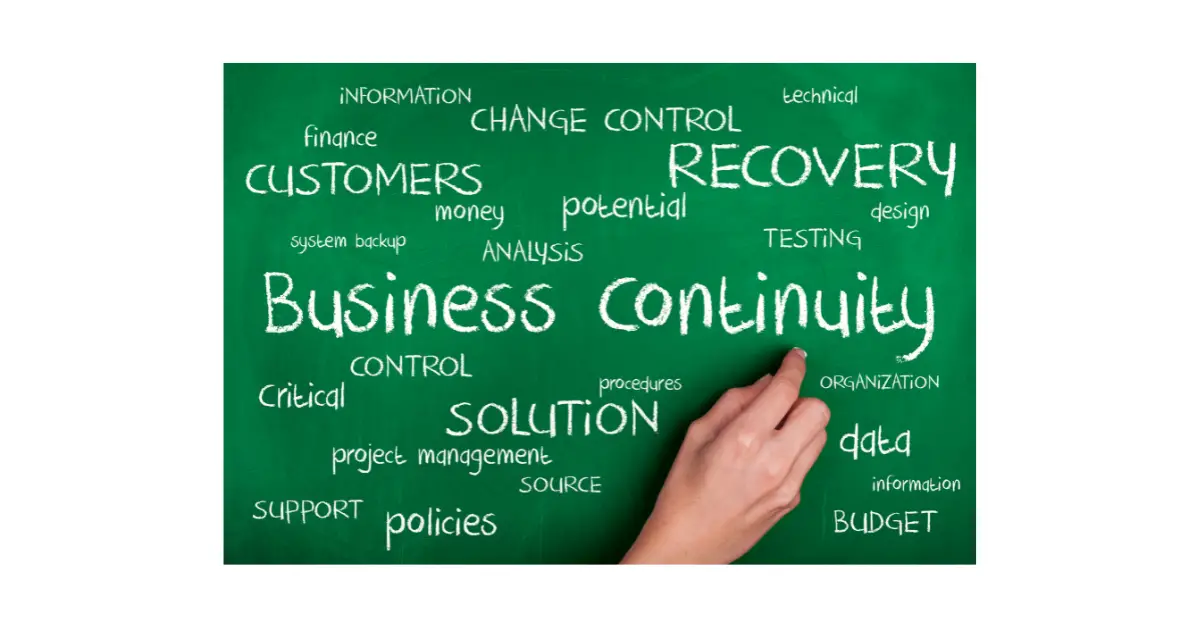Enterprise business continuity refers to the processes and strategies that are employed in order to keep a company running smoothly and effectively in the face of various operational challenges. These disruptions can range from unexpected systems failures to natural disasters and human-caused catastrophes.
By implementing a rigorous business continuity plan, organizations are better able to keep their operations running smoothly even in the face of difficulty. This allows them to serve their customers and stakeholders effectively, reducing losses and preventing major interruptions in the flow of business functions.
At the core of enterprise business continuity is the ability to effectively mitigate risk, maintain high levels of operational efficiency, and preserve the integrity and security of critical data and information.
In order to achieve these goals, companies must typically have robust systems in place for managing resources, scaling up or down as needed, and rapidly responding to various threats and disruptions. Ultimately, enterprise business continuity is crucial for ensuring that businesses can continue to thrive in a rapidly changing economic landscape.
In line with this, Business continuity is the process of planning for the continuity of essential functions of an organization in the event of a disruptive incident. Disruptive incidents can include power outages, cyber-attacks, natural disasters, and pandemics.
The key elements of business continuity planning are identifying essential functions, determining vulnerabilities, and developing mitigation strategies. The goal is to minimize the impact of a disruptive incident on operations and ensure a quick and efficient recovery. Business continuity planning is essential for all organizations, as it can help to prevent or reduce significant losses.
A business continuity plan (BCP) is a plan to help an organization continue operating despite major disruptive events. The goal of a BCP is to reduce the likelihood of disruptions and minimize the impact of those that do occur.
A key part of any BCP is identifying which business processes are critical to the organization and ensuring that those processes can be quickly resumed in the event of a disruption. Another important element is developing procedures for alternate modes of operation, such as working remotely or using temporary facilities.
Business continuity planning is typically led by business continuity professionals who have expertise in risk management, crisis management, and disaster recovery. The goal is to create a plan that can be easily implemented by all staff members in the event of a disruptive incident.
What is Enterprise Continuity?
Enterprise continuity is the process of ensuring that a business is able to continue operating in the event of disruptions or crises. This often involves creating plans and implementing systems for dealing with various contingencies, such as natural disasters, power outages, cyberattacks, or employee emergencies.
The ultimate goal of enterprise continuity is to maintain normal business operations at all times, protecting both the company and its customers. Whether you are the owner of a small start-up or the CFO of a large corporation, an effective enterprise continuity plan can help to ensure your success in today’s fast-paced and ever-changing business environment.
It is a technique to protect a firm’s work against interruption. A business plan usually consists of a logical hope for something that might fall apart. In fact, COVID-19 led companies to serious process development.
What are the 3 Elements of Business Continuity?
Business continuity is the ability of an organization to keep functioning during and after a disruptive event. The three elements of business continuity are people, process, and technology.
People are the most important element of business continuity. Employees must be trained on what to do in the event of an incident and be familiar with the organization’s Continuity of Operations Plan. They must also know who to contact for help and where to find information.
Processes are the second element of business continuity. Processes must be in place so that the organization can continue to function even if some employees are unable to come to work. These processes must be documented and tested so that they can be followed in an emergency.
Technology is the third element of business continuity. Technology systems must be robust and redundant so that they can continue to operate even if there is a power outage or other disruptions. Data must be backed up and stored in multiple locations so that it can be accessed if the primary site is unavailable.
What Does Business Continuity Include?
Business continuity plans outline ways to maintain your company’s operation in case of unplanned disruptions. Company continuity plans include, for example, data recovery procedures and backup strategies for restoring offices’ productive capacities and communications guidelines.
In the world of business, continuity is one of the most important concepts to understand. Simply put, business continuity refers to a company’s ability to remain operational in the face of disruptions or crises, such as natural disasters, technical malfunctions, or financial problems. This requires extensive planning and diligence on the part of all members of the organization, including executives, managers, and employees alike.
At its core, business continuity includes a wide range of practices that help companies minimize their risk exposure and ensure that important tasks are completed even when unexpected obstacles arise. Some key components include risk assessments, backup systems for all essential data and processes, cross-training among different teams and departments, emergency drills and policies for handling emergency situations both internally and externally, and contingency plans for different types of crises.
By ensuring that all team members are prepared to handle any situation at a moment’s notice, businesses can maintain high levels of productivity even in times of adversity. Ultimately, this allows them to achieve continued success in their quest to grow and thrive in today’s rapidly changing economy.

What are the 5 Components of a Business Continuity Plan?
To create a successful business continuity plan, there are several key components that must be addressed. These include assessing risks to the business, developing actionable recovery strategies, establishing clear roles and responsibilities for all team members involved, building redundancies into critical systems and processes, and regularly updating and testing the plan.
By focusing on each of these elements, businesses can develop robust plans that help them to weather any type of unexpected disruption or emergency. Whether it’s a natural disaster, cyberattack, power outage, supply chain hiccup, or any other issue that could potentially impact their operations, businesses with strong continuity plans are well equipped to respond quickly and effectively.
So if you’re looking to create a long-lasting business continuity strategy for your organization, keep these vital aspects in mind at every step along the way.
A business continuity response team is a group of individuals who are responsible for developing and implementing plans to keep a business running in the event of a disaster occurs. The team typically includes representatives from various departments, such as finance, human resources, and operations.
One of the most important tasks of the team is to conduct a business impact analysis, which assists in identifying which functions are critical to the business and which can be temporarily suspended in the event of a disruption.
The team also develops plans for alternate work locations and communication channels, as well as procedures for safeguarding critical data and other assets. In the event that a disaster occurs, the business continuity response team is responsible for coordinating the efforts of all employees to ensure that the business can continue to operate.
The financial industry regulatory authority is an independent regulator that oversees the securities industry and protects investors from fraud. The authority is responsible for enforcing rules and regulations, conducting examinations, and maintaining databases.
One of the key functions of the authority is to provide information to investors so that they can make informed decisions about their investments. The authority also works to prevent insider trading and other forms of fraud. In the event of a disaster, the financial industry regulatory authority would be responsible for ensuring that markets remain orderly and providing information.
How to approach enterprise BCP in 2022?
The idea of what might happen when the Internet fails is difficult for a company. Many modern businesses operate within digital worlds, which can be devastating losses. The Gartner Institute estimates an average company can save $300,000. In addition, prolonged downtime events can damage your image irreparably.
Companies believe the average hour required by a small firm is $300,000. Long-lasting events can damage a business in a significant way. A strategy for the future is now crucial. What are some of these risks? If you take a look at what was most disastrous then plan on doing the best you can to get a better survival outcome.
The importance of planning for continuity of operations continues to grow. Thinking about it might seem too much, but preparing to face the worst can make you safer in the event of a catastrophic accident.
As businesses grapple with the fallout of the COVID-19 pandemic, many are turning their attention to business continuity planning (BCP). BCP helps organizations to prepare for and respond to disruptive events, minimizing the impact on operations and ensuring that critical functions can continue. As we look ahead to 2022, there are a number of factors that should be considered when approaching enterprise BCP.
First, it is important to assess the risks that your organization faces. What are the most likely disruptors? What would be the impact of each of these? What steps can you take to mitigate the risks?
Second, you need to identify your critical functions and operations. What are the essential components of your business? What must continue in order for your business to survive? What are the key dependencies that need to be taken into account?
Third, you need to develop plans and procedures for how your organization will respond to a disruptor. Who will be responsible for each task? What resources will you need? How will you communicate with employees and other stakeholders? By taking these steps, you can ensure that your organization is prepared for whatever challenges lie ahead in 2022.
Business Continuity Management
This term describes a series of proactive, reactive, and managerial activities which deal with the dangers such as tremors, sandblasted earthquakes, tsunamis, and floods. It can reduce disruption to the organizational tasks of a large business during busy days — which may lead to considerable financial losses.
It is aimed at keeping an organization functioning in an emergency. A critical aspect of every plan is an emergency plan, which decides how one can talk, regain connection to a computer system and keep equipment that has been destroyed or defaced by malicious activities.
In the world of business, success is absolutely dependent on effective operations. This involves managing risks, preparing for possible disruptions, and ensuring that normal operations are able to continue even in the midst of chaos. One important element of successful business operations is a solid enterprise risk management strategy.
It requires identifying potential risks and understanding how to respond to them when they arise. Recovery strategies and tools like automation can also help to keep business units running smoothly even when unexpected events or crises occur. And of course, data loss is always a major concern, as it can degrade overall performance and compromise the security of sensitive information. Through careful planning and solid execution, however, businesses can thrive by maintaining safe, stable, and efficient operations at all times.

What is Business Continuity Management?
The term business continuity management refers to a holistic approach that identifies possible risks that could be caused to an organization if realized – and provides a framework for a successful management response that protects the organization. International Dictionary of Resilience. Business continuity management (BCM) combines disaster management, disaster management technology continuity, and business continuity.
Importance of Business Continuity
Business continuity refers to the ability of an organization to maintain critical functions during or after a catastrophe. The plan is designed for the organization’s business continuity, avoiding interruption of essential operations. The most basic business continuity needs will remain in place and work through a disaster. A business continuity plan takes into consideration unforeseen situations such as fire and natural disasters, virus infections, and cyber attacks.
Small businesses are the backbone of the American economy, and they play an important role in communities across the country. Rapid response is a critical part of maintaining a successful small business. When customers have a problem or concern, they want to know that the business will respond quickly and effectively.
That’s why dri international has developed a rapid response program specifically for small businesses. This program provides guidance on how to create and maintain an effective rapid response plan. It covers everything from identifying minor issues before they become major problems to responding quickly to customer concerns. most importantly, it helps businesses in creating and maintaining a culture of responsiveness among employees.
Demands by Organizations for their Vendors
Customer needs: Request for proposals (RFP) requires prospective suppliers to prove that they have Business Continuity Management systems. Regulation: There’s a regulation that governs preparedness across supply chains. Federally registered banks are also subject to the regulation and oversight of federal banks and federal savings agencies, The Federal Deposit Insurance Corporation and Federal Reserve Banks are regulated by the federal government. For healthcare companies, HIPAA covers all regulatory considerations of their supply chain.
Legal and regulatory compliance
Regulatory requirements: There are more than 120 laws mandated in many different industries including Negligence: Court decisions based on Common law have ruled out both failures in planning and failure in execution. The word negligence refers to a breach by someone to the degree that prudent people would have used in similar circumstances.
An organization’s ability to withstand and recover from disruptions while still achieving its goals is often referred to as organizational resilience. Many factors can contribute to organizational resilience, including legal and regulatory compliance.
By adhering to laws and regulations, organizations can create clear lines of responsibility and accountability, which can help them quickly identify and address problems when they arise. Additionally, compliance with laws and regulations helps to build trust with stakeholders, which can be essential in times of crisis. While no organization is completely immune to the effects of disruptions, those that are compliant with relevant laws and regulations are often better positioned to weather the storm.
Value of Business Continuity Management
Business continuity management programs are often needed to ensure that business continuity is maintained across the company. A well-run business continuity management program will help to protect the company’s reputation, customers, and other stakeholders. It can also help to reduce the costs associated with downtime and disruptions.
A business continuity management program should be designed to meet the specific needs of the company. It should be flexible enough to accommodate changes in the business environment and the company’s operations. The program should be reviewed and updated regularly to ensure that it is still relevant and effective.
A business continuity management program can help to:
- Protect the company’s reputation
- Reduce the costs associated with downtime and disruptions
- Ensure that business continuity is maintained across the company
- Help to restore normal operations
Tell me the Importance of Business Continuity Planning?
It is essential to have business continuity plans. Secondly, this will ensure you can remain active in times when significant disruption occurs. It may be any natural or cybercrime. This also allows you to make contingencies a priority to minimize disruption. Ultimately, good continuity management is essential in maximizing your resilience. Creating an ideal solution for every situation can increase your business potential. The business’s goals are mostly dependent on staff processes.
Disaster recovery planning is an essential part of any organization or business. When dealing with such an event that has the potential to disrupt business operations, it is critical to have a disaster recovery plan in place that accounts for not only the initial impact of the disaster but also the time needed to get back up and running.
This process typically involves setting a recovery time objective, or RTO, which puts a time limit on how long it should take an organization to recover from a disruption. Additionally, effective disaster recovery plans also involve crisis management techniques such as identifying key stakeholders and updating communication strategies during an emergency response. Overall, having a well-crafted disaster recovery plan is essential for minimizing downtime and ensuring the continued success of any organization.
Anatomy of a business continuity plan
It’s important to first look at a business process whether it’s a software system or an application that’s not yet installed. In preparing for a shutdown, analyzing potential losses is a crucial first phase in any plan. When developing strategic plans, consider contacting key executives of the company. DR plan aims at the implementation of strategies in crisis situations and is crucial in planning. You have to take into consideration these things in your plan.
A company’s plan should always be to protect its interests, its shareholders, and its employees. While no company is perfect, and there are always potential threats, by being proactive and having a plan in place, a company can reduce the chances of an emerging crisis. The analysis phase is critical to this process – by taking the time to understand the risks, a company can develop strategies to mitigate them. In today’s interconnected world, where news can spread instantly, it is more important than ever for companies to be prepared for any eventuality.

Chris Ekai is a Risk Management expert with over 10 years of experience in the field. He has a Master’s(MSc) degree in Risk Management from University of Portsmouth and is a CPA and Finance professional. He currently works as a Content Manager at Risk Publishing, writing about Enterprise Risk Management, Business Continuity Management and Project Management.


